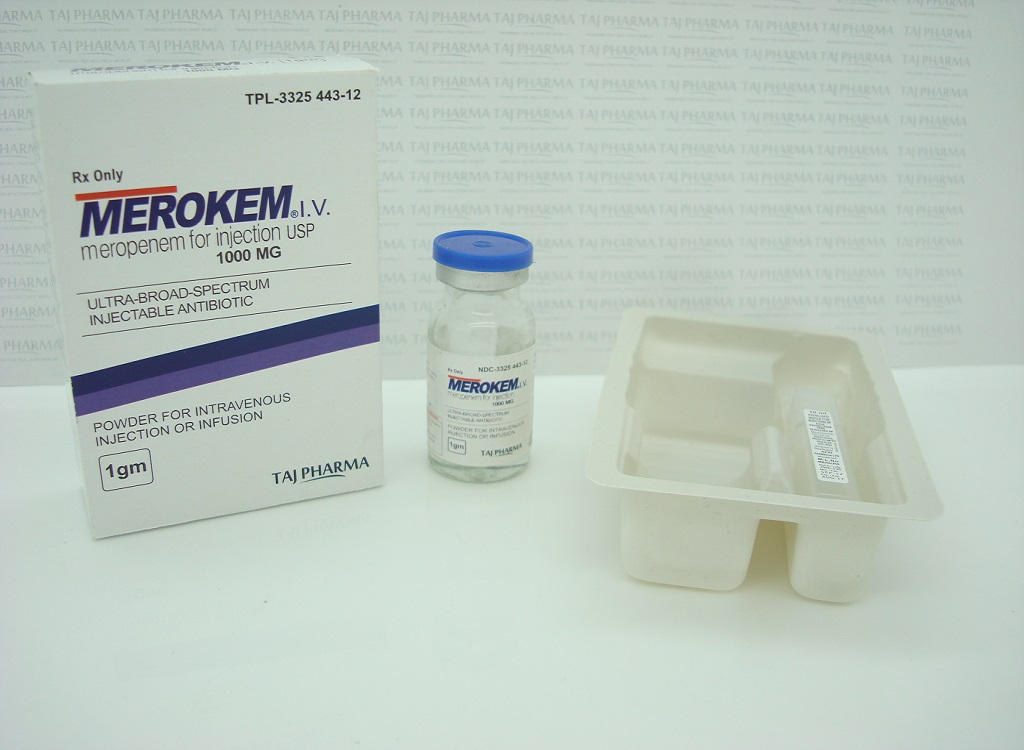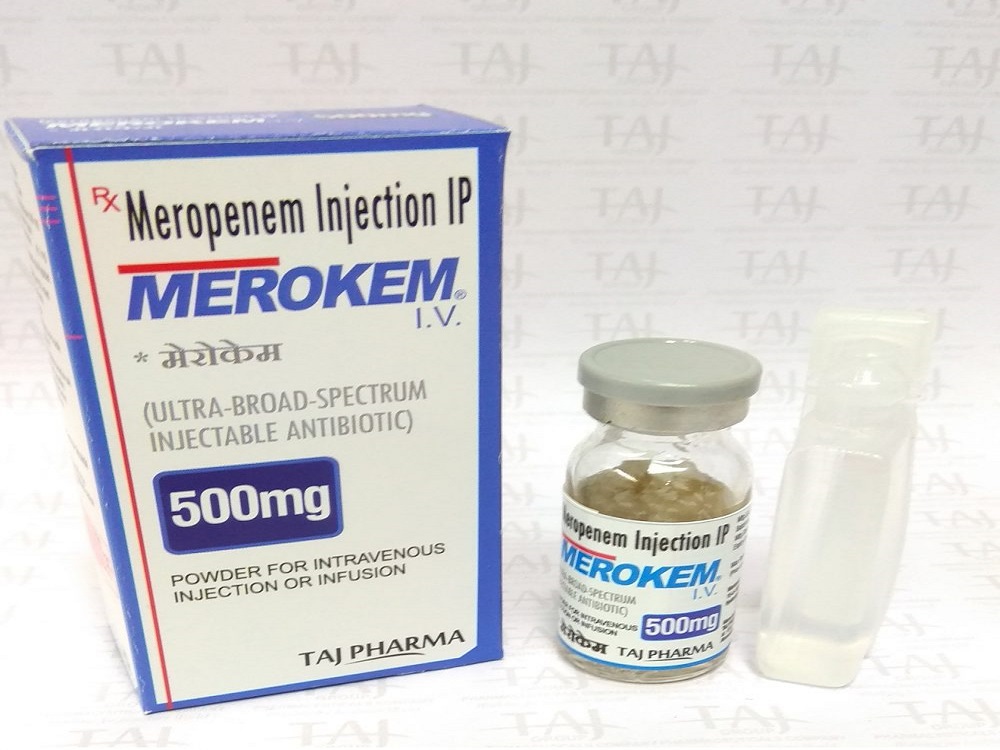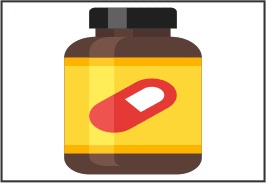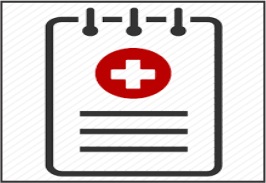MEROPENEM POWDER FOR SOLUTION FOR INJECTION OR INFUSION 500MG, 1G
1 Name of the medicinal product
Meropenem 500 mg Powder for Solution for Injection or Infusion
2 Qualitative and quantitative composition
Each vial contains meropenemtrihydrate equivalent to 500 mg anhydrous meropenem.
When reconstituted with 10 ml sterile Water for Injections, each ml contains 50 mg meropenem.
Excipients(s) with known effect:
Each 500 mg vial contains 104 mg sodium carbonate which equates to approximately 2.0 mEq of sodium (approximately 45 mg).
3 Pharmaceutical form
Powder for solution for injection or infusion.
A white to pale yellow powder.
4 Clinical particulars
4.1 Therapeutic indications
Meropenem is indicated for the treatment of the following infections in adults and children over 3 months of age.
• Severe pneumonia, including hospital and ventilator-associated pneumonia.
• Broncho-pulmonary infections in cystic fibrosis
• Complicated urinary tract infections
• Complicated intra-abdominal infections
• Intra- and post-partum infections
• Complicated skin and soft tissue infections
• Acute bacterial meningitis
Treatment of patients with bacteraemia that occurs in association with, or is suspected to be associated with, any of the infections listed above.
Meropenem may be used in the management of neutropenic patients with fever that is suspected to be due to a bacterial infection.
Consideration should be given to official guidance on the appropriate use of antibacterial agents.
4.2 Posology and method of administration
The tables below provide general recommendations for dosing.
The dose of Meropenem administered and the duration of treatment should take into account the type of infection to be treated, including its severity, and the clinical response.
A dose of up to 2 g three times daily in adults and adolescents and a dose of up to 40 mg/kg three times daily in children may be particularly appropriate when treating some types of infections, such as infections due to less susceptible bacterial species (e.g. Enterobacteriaceae, Pseudomonas aeruginosa or Acinetobacter spp.), or very severe infections.
Additional considerations for dosing are needed when treating patients with renal insufficiency (see further below).
Adults and Adolescents
| Infection | Dose to be administered every 8 hours |
| Severe pneumonia including hospital and ventilator-associated pneumonia | 500 mg or 1 g |
| Broncho-pulmonary infections in cystic fibrosis | 2 g |
| Complicated urinary tract infections | 500 mg or 1 g |
| Complicated intra-abdominal infections | 500 mg or 1 g |
| Intra- and post-partum infections | 500 mg or 1 g |
| Complicated skin and soft tissue infections | 500 mg or 1 g |
| Acute bacterial meningitis | 2 g |
| Management of febrile neutropenic patients | 1 g |
Meropenemis usually given by intravenous infusion over approximately 15 to 30 minutes.
Alternatively, doses up to 1 g can be given as an intravenous bolus injection over approximately 5 minutes. There are limited safety data available to support the administration of a 2 g dose in adults as an intravenous bolus injection.
Renal impairment
The dose for adults and adolescents should be adjusted when creatinine clearance is less than 51 ml/min, as shown below. There are limited data to support the application of these dose adjustments for a unit dose of 2 g.
| Creatinine clearance (ml/min) | Dose (based on “unit” dose range of 500 mg or 1 g or 2 g, see table above) | Frequency |
| 26 - 50 | one unit dose | every 12 hours |
| 10 - 25 | half of one unit dose | every 12 hours |
| < 10 | half of one unit dose | every 24 hours |
Meropenem is cleared by haemodialysis and haemofiltration. The required dose should be administered after completion of the haemodialysis cycle.
There are no established dose recommendations for patients receiving peritoneal dialysis.
Hepatic impairment
No dose adjustment is necessary in patients with hepatic impairment.
Dose in elderly patients
No dose adjustment is required for the elderly with normal renal function or creatinine clearance values above 50 ml/min.
Paediatric population
Children under 3 months of age
The safety and efficacy of Meropenem in children under 3 months of age have not been established and the optimal dose regimen has not been identified. However, limited pharmacokinetic data suggest that 20 mg/kg every 8 hours may be an appropriate regimen.
Children from 3 months to 11 years of age and up to 50 kg body weight
The recommended dose regimens are shown in the table below:
| Infection | Dose to be administered every 8 hours |
| Severe pneumonia including hospital and ventilator-associated pneumonia | 10 or 20 mg/kg |
| Broncho-pulmonary infections in cystic fibrosis | 40 mg/kg |
| Complicated urinary tract infections | 10 or 20 mg/kg |
| Complicated intra-abdominal infections | 10 or 20 mg/kg |
| Complicated skin and soft tissue infections | 10 or 20 mg/kg |
| Acute bacterial meningitis | 40 mg/kg |
| Management of febrile neutropenic patients | 20 mg/kg |
Children over 50 kg body weight
The adult dose should be administered.
There is no experience in children with renal impairment.
Meropenem is usually given by intravenous infusion over approximately 15 to 30 minutes (see sections 6.2, 6.3 and 6.6). Alternatively, meropenem doses of up to 20 mg/kg may be given as an intravenous bolus over approximately 5 minutes. There are limited safety data available to support the administration of a 40 mg/kg dose in children as an intravenous bolus injection.
For instructions on reconstitution and dilution of the medicinal product before administration.
4.3 Contraindications
Hypersensitivity to the active substance or to any of the excipients listed in section 6.1.
Hypersensitivity to any other carbapenem antibacterial agent.
Severe hypersensitivity (e.g. anaphylactic reaction, severe skin reaction) to any other type of beta-lactam antibacterial agent (e.g. penicillins or cephalosporins).
4.4 Special Warnings and precautions for use
The selection of meropenem to treat an individual patient should take into account the appropriateness of using a carbapenem antibacterial agent based on factors such as severity of the infection, the prevalence of resistance to other suitable antibacterial agents and the risk of selecting for carbapenem-resistant bacteria.
Enterobacteriaceae, Pseudomonas aeruginosa and Acinetobacter spp. resistance
Resistance to penems of Enterobacteriaceae, Pseudomonas aeruginosa, Acinetobacter spp. varies across the European Union. Prescribers are advised to take into account the local prevalence of resistance in these bacteria to penems.
Hypersensitivity reactions
As with all beta-lactam antibiotics, serious and occasionally fatal hypersensitivity reactions have been reported.
Patients who have a history of hypersensitivity to carbapenems, penicillins or other beta-lactam antibiotics may also be hypersensitive to Meropenem. Before initiating therapy with Meropenem, careful enquiry should be made concerning previous hypersensitivity reactions to beta-lactam antibiotics.
If a severe allergic reaction occurs, the medicinal product should be discontinued and appropriate measures taken.
Antibiotic-associated colitis
Antibiotic-associated colitis and pseudomembranous colitis have been reported with nearly all anti-bacterial agents, including meropenem, and may range in severity from mild to life threatening. Therefore, it is important to consider this diagnosis in patients who present with diarrhoea during or subsequent to the administration of meropenem (see section 4.8). Discontinuation of therapy with meropenem and the administration of specific treatment for Clostridium difficile should be considered.
Medicinal products that inhibit peristalsis should not be given.
Seizures
Seizures have infrequently been reported during treatment with carbapenems, including meropenem.
Hepatic function monitoring
Hepatic function should be closely monitored during treatment with meropenem due to the risk of hepatic toxicity (hepatic dysfunction with cholestasis and cytolysis).
Use in patients with liver disease: patients with pre-existing liver disorders should have liver function monitored during treatment with meropenem. There is no dose adjustment necessary.
Direct antiglobulin test (Coombs test) seroconversion
A positive direct or indirect Coombs test may develop during treatment with meropenem.
Concomitant use with valproic acid/sodium valproate/valpromide
The concomitant use of meropenem and valproic acid/sodium valproate/valpromide is not recommended.
Paediatric population
Meropenem is licensed for children over 3 months of age. There is no evidence of an increased risk of any adverse drug reaction in children based on the limited available data. All reports received were consistent with events observed in the adult population.
Meropenem contains sodium.
Meropenem 500 mg Powder for Solution for Injection or Infusion contains approximately 2.0 mEq of sodium per vial which should be taken into consideration by patients on a controlled sodium diet.
4.5 Interaction with other medicinal products and other forms of interaction
No specific medicinal product interaction studies other than probenecid have been conducted. Probenecid competes with meropenem for active tubular secretion and thus inhibits the renal excretion of meropenem with the effect of increasing the elimination half-life and plasma concentration of meropenem. Caution is required if probenecid is co-administered with meropenem.
The potential effect of meropenem on the protein binding of other medicinal products or metabolism has not been studied. However, the protein binding is so low that no interactions with other compounds would be expected on the basis of this mechanism.
Decreases in blood levels of valproic acid have been reported when it is co-administered with carbapenem agents resulting in 60-100% decrease in valproic acid levels in about two days. Due to the rapid onset and the extent of the decrease, co-administration of valproic acid/sodium valproate/valpromide with carbapenem agents is not considered to be manageable and therefore should be avoided
Oral anti-coagulants
Simultaneous administration of antibiotics with warfarin may augment its anti-coagulant effects. There have been many reports of increases in the anti-coagulant effects of orally administered anti-coagulant agents, including warfarin in patients who are concomitantly receiving antibacterial agents. The risk may vary with the underlying infection, age and general status of the patient so that the contribution of the antibiotic to the increase in INR (international normalised ratio) is difficult to assess. It is recommended that the INR should be monitored frequently during and shortly after co-administration of antibiotics with an oral anti-coagulant agent.
4.6 Fertility, pregnancy and lactation
Pregnancy
There are no or limited amount of data from the use of meropenem in pregnant women. Animal studies do not indicate direct or indirect harmful effects with respect to reproductive toxicity (see section 5.3). As a precautionary measure, it is preferable to avoid the use of meropenem during pregnancy.
Breast-feeding
Small amounts of meropenem have been reported to be excreted in human milk. Meropenem should not be used in breast-feeding women unless the potential benefit for the mother justifies the potential risk to the baby.
4.7 Effects on ability to drive and use machines
No studies on the effect on the ability to drive and use machines have been performed. However, when driving or operating machines, it should be taken into account that headache, paraesthesiae and convulsions have been reported for meropenem.
4.8 Undesirable Effects
Summary of the safety profile
In a review of 4,872 patients with 5,026 meropenem treatment exposures, meropenem-related adverse reactions most frequently reported were diarrhoea (2.3%), rash (1.4%), nausea/vomiting (1.4%) and injection site inflammation (1.1%). The most commonly reported meropenem-related laboratory adverse events were thrombocytosis (1.6%) and increased hepatic enzymes (1.5-4.3%).
Adverse reactions listed in the table with a frequency of “not known” were not observed in the 2,367 patients who were included in pre-authorisation clinical studies with intravenous and intramuscular meropenem but have been reported during the post-marketing period.
Tabulated list of adverse reactions
In the table below, all adverse reactions are listed by system organ class and frequency: very common (≥1/10); common (≥1/100 to <1/10); uncommon (≥1/1,000 to <1/100); rare (≥1/10,000 to <1/1,000); very rare (<1/10,000) and not known (cannot be estimated from the available data). Within each frequency grouping, undesirable effects are presented in order of decreasing seriousness.
| System Organ Class | Frequency | Event |
| Infections and infestations | Uncommon | Oral and vaginal candidiasis |
| Blood and lymphatic system disorders | Common | Thrombocythaemia |
| Uncommon | Eosinophilia, thrombocytopenia, leucopenia, neutropenia, agranulocytosis, haemolyticanaemia | |
| Immune system disorders | Uncommon | Angioedema, anaphylaxis (see sections 4.3 and 4.4) |
| Nervous system disorders | Common | Headache |
| Uncommon | Paraesthesiae | |
| Rare | Convulsions (see section 4.4) | |
| Gastrointestinal disorders | Common | Diarrhoea, vomiting, nausea, abdominal pain |
| Uncommon | Antibiotic-associated colitis (see section 4.4) | |
| Hepatobiliary disorders | Common | Transaminases increased, blood alkaline phosphatase increased, blood lactate dehydrogenase increased |
| Uncommon | Blood bilirubin increased | |
| Skin and subcutaneous tissue disorders | Common | Rash, pruritis |
| Uncommon | Urticaria, toxic epidermal necrolysis, Stevens Johnson syndrome, erythema multiforme | |
| Unknown | Drug reaction with eosinophilia and systemic symptoms (DRESS syndrome) | |
| Renal and urinary disorders | Uncommon | Blood creatinine increased, blood urea increased |
| General disorders and administration site conditions | Common | Inflammation, pain |
| Uncommon | Thrombophlebitis, pain at the injection site | |
Reporting of suspected adverse reactions
Reporting suspected adverse reactions after authorisation of the medicinal product is important. It allows continued monitoring of the benefit/risk balance of the medicinal product.
4.9 Overdose
Relative overdose may be possible in patients with renal impairment if the dose is not adjusted as described in section 4.2. Limited post-marketing experience indicates that if adverse reactions occur following overdose, they are consistent with the adverse reaction profile described in section 4.8, are generally mild in severity and resolve on withdrawal or dose reduction. Symptomatic treatments should be considered.
| Organism | Susceptible (S) (mg/l) | Resistant (R) (mg/l) |
| Enterobacteriaceae | ≤2 | >8 |
| Pseudomonas spp. | ≤2 | >8 |
| Acinetobacter spp. | ≤2 | >8 |
| Streptococcus groups A, B, C and G | note 6 | note 6 |
| Streptococcus pneumoniae1 | ≤2 | >2 |
| Viridans group streptococci2 | ≤2 | >2 |
| Enterococcus spp | -- | -- |
| Staphylococcus spp | note 3 | note 3 |
| Haemophilus influenzae1,2 and Moraxella catarrhalis2 | ≤2 | >2 |
| Neisseria meningitidis2,4 | ≤0.25 | >0.25 |
| Gram-positive anaerobes except Clostridium difficile | ≤2 | >8 |
| Gram-negative anaerobes | ≤2 | >8 |
| Listeria monocytogenes | ≤0.25 | >0.25 |
| Non-species related breakpoints5 | ≤2 | >8 |
In individuals with normal renal function, rapid renal elimination will occur. Haemodialysis will remove meropenem and its metabolite.
5 Pharmacological properties
5.1 Pharmacodynamic properties
Pharmacotherapeuticgroup: antibacterials for systemic use, carbapenems, ATC code: J01DH02
Mode of action
Meropenem exerts its bactericidal activity by inhibiting bacterial cell wall synthesis in Gram-positive and Gram-negative bacteria through binding to penicillin-binding proteins (PBPs).
Pharmacokinetic/Pharmacodynamic (PK.PD) relationship
Similar to other beta-lactam antibacterial agents, the time that meropenem concentrations exceed the MIC (T>MIC) has been shown to best correlate with efficacy. In preclinical models meropenem demonstrated activity when plasma concentrations exceeded the MIC of the infecting organisms for approximately 40% of the dosing interval. This target has not been established clinically.
Mechanism of resistance
Bacterial resistance to meropenem may result from: (1) decreased permeability of the outer membrane of Gram-negative bacteria (due to diminished production of porins) (2) reduced affinity of the target PBPs (3) increased expression of efflux pump components, and (4) production of beta-lactamases that can hydrolysecarbapenems.
Localised clusters of infections due to carbapenem-resistant bacteria have been reported in the European Union.
There is no target-based cross-resistance between meropenem and agents of the quinolone, aminoglycoside, macrolide and tetracycline classes. However, bacteria may exhibit resistance to more than one class of antibacterial agents when the mechanism involved includes impermeability and/or an efflux pump(s).
Breakpoints
European Committee on Antimicrobial Susceptibility Testing (EUCAST) clinical breakpoints for MIC testing are presented below.
EUCAST clinical MIC breakpoints for meropenem (2013-02-11, v 3.1)
1 Meropenem breakpoints for Streptococcus pneumoniae and Haemophilusinfluenzae in meningitis are 0.25 mg/L (Susceptible) and 1 mg/L (Resistant).
2 Isolates with MIC values above the susceptible breakpoint are very rare or not yet reported. The identification and antimicrobial susceptibility tests on any such isolate must be repeated and if the result is confirmed the isolate sent to a reference laboratory. Until there is evidence regarding clinical response for confirmed isolates with MIC values above the current resistant breakpoint they should be reported as resistant.
3 Susceptibility of staphylococci to carbapenems is inferred from the cefoxitin susceptibility.
4 Breakpoints relate to meningitis only.
5 Non-species related breakpoints have been determined using PK/PD data and are independent of MIC distributions of specific species. They are for use only for organisms that do not have specific breakpoints. Non species related breakpoints are based on the following dosages: EUCAST breakpoints apply to meropenem 1000 mg x 3 daily administered intravenously over 30 minutes as the lowest dose. 2 g x 3 daily was taken into consideration for severe infections and in setting the I/R breakpoint.
6 The beta-lactam susceptibility of streptococcus groups A, B, C and G is inferred from the penicillin susceptibility.
-- = Susceptibility testing not recommended as the species is a poor target for therapy with the medicinal product.Isolates may be reported as R without prior testing.
The prevalence of acquired resistance may vary geographically and with time for selected species and local information on resistance is desirable, particularly when treating severe infections. As necessary, expert advice should be sought when the local prevalence of resistance is such that the utility of the agent in at least some types of infections is questionable.
The following table of pathogens listed is derived from clinical experience and therapeutic guidelines.
Commonly susceptible species
Gram-positive aerobes
Enterococcus faecalis$
Staphylococcus aureus (methicillin-susceptible)£
Staphylococcus species (methicillin-susceptible) including Staphylococcus epidermidis
Streptococcus agalactiae (Group B)
Streptococcus milleri group (S. anginosus, S. constellatus, and S. intermedius)
Streptococcus pneumoniae
Streptococcus pyogenes (Group A)
Gram-negative aerobes
Citrobacterfreudii
Citrobacterkoseri
Enterobacteraerogenes
Enterobacter cloacae
Escherichia coli
Haemophilusinfluenzae
Klebsiellaoxytoca
Klebsiellapneumoniae
Morganellamorganii
Neisseria meningitides
Proteus mirabilis
Proteus vulgaris
Serratiamarcescens
Gram-positive anaerobes
Clostridium perfringens
Peptoniphilusasaccharolyticus
Peptostreptococcus species (including P. micros, P. anaerobius, P. magnus)
Gram-negative anaerobes
Bacteroidescaccae
Bacteroidesfragilis group
Prevotellabivia
Prevotelladisiens
Species for which acquired resistance may be a problem
Gram-positive aerobes
Enterococcus faecium $†
Gram-negative aerobes
Acinetobacter species
Burkholderiacepacia
Pseudomonas aeruginosa
Inherently resistant organisms
Gram-negative aerobes
Stenotrophomonasmaltophilia
Legionella species
Other micro-organisms
Chlamydophilapneumoniae
Chlamydophilapsittaci
Coxiellaburnetii
Mycoplasma pneumoniae
$ Species that show natural intermediate susceptibility
£ All methicillin-resistant staphylococci are resistant to meropenem
† Resistance rate ≥ 50% in one or more EU countries
Glanders and melioidosis: Use of meropenem in humans is based on in vitro B.
mallei and B.pseudomallei susceptibility data and on limited human data. Treating physicians should refer to national and/or international consensus documents regarding the treatment of glanders and melioidosis.
5.2 Pharmacokinetic properties
In healthy subjects the mean plasma half-life is approximately 1 hour; the mean volume of distribution is approximately 0.25 l/kg (11-27 l) and the mean clearance is 287 ml/min at 250 mg falling to 205 ml/min at 2 g. Doses of 500, 1000 and 2000 mg doses infused over 30 minutes give mean Cmax values of approximately 23, 49 and 115 µg/ml respectively, corresponding AUC values were 39.3, 62.3 and 153 µg.h/ml. After infusion over 5 minutes Cmax values are 52 and 112 µg/ml after 500 and 1000 mg doses respectively. When multiple doses are administered 8-hourly to subjects with normal renal function, accumulation of meropenem does not occur.
A study of 12 patients administered meropenem 1000 mg 8 hourly post-surgically for intra-abdominal infections showed a comparable Cmax and half-life to normal subjects but a greater volume of distribution 27 l.
Distribution
The average plasma protein binding of meropenem was approximately 2% and was independent of concentration. After rapid administration (5 minutes or less) the pharmacokinetics are biexponential but this is much less evident after 30 minutes infusion. Meropenem has been shown to penetrate well into several body fluids and tissues: including lung, bronchial secretions, bile, cerebrospinal fluid, gynaecological tissues, skin, fascia, muscle, and peritoneal exudates.
Metabolism
Meropenem is metabolised by hydrolysis of the beta-lactam ring generating a microbiologically inactive metabolite. In vitro meropenem shows reduced susceptibility to hydrolysis by human dehydropeptidase-I (DHP-I) compared to imipenem and there is no requirement to co-administer a DHP-I inhibitor.
Elimination
Meropenem is primarily excreted unchanged by the kidneys; approximately 70% (50-75%) of the dose is excreted unchanged within 12 hours. A further 28% is recovered as the microbiologically inactive metabolite. Faecal elimination represents only approximately 2% of the dose. The measured renal clearance and the effect of probenecid show that meropenem undergoes both filtration and tubular secretion.
Renal insufficiency
Renal impairment results in higher plasma AUC and longer half-life for meropenem. There were AUC increases of 2.4 fold in patients with moderate impairment (CrCL 33-74 ml/min), 5 fold in severe impairment (CrCL 4-23 ml/min) and 10 fold in haemodialysis patients (CrCL<2 ml/min) when compared to healthy subjects (CrCL>80 ml/min). The AUC of the microbiologically inactive ring opened metabolite was also considerably increased in patients with renal impairment. Dose adjustment is recommended for patients with moderate and severe renal impairment (see section 4.2).
Meropenem is cleared by haemodialysis with clearance during haemodialysis being approximately 4 times higher that in anuric patients.
Hepatic insufficiency
A study in patients with alcoholic cirrhosis shows no effect of liver disease on the pharmacokinetics of meropenem after repeated doses.
Adult patients
Pharmacokinetic studies performed in patients have not shown significant pharmacokinetic differences versus healthy subjects with equivalent renal function. A population model developed from data in 79 patients with intra-abdominal infection or pneumonia, showed a dependence of the central volume on weight and the clearance on creatinine clearance and age.
Paediatric population
The pharmacokinetics in infants and children with infection at doses of 10, 20 and 40 mg/kg showed Cmax values approximating to those in adults following 500, 1000 and 2000 mg doses, respectively. Comparison showed consistent pharmacokinetics between the doses and half-lives similar to those observed in adults in all but the youngest subjects (<6 months t1/2 1.6 hours). The mean meropenem clearance values were 5.8 ml/min/kg (6-12 years), 6.2 ml/min/kg (2-5 years), 5.3 ml/min/kg (6-23 months) and 4.3 ml/min/kg (2-5 months). Approximately 60% of the dose is excreted in urine over 12 hours as meropenem with a further 12% as metabolite. Meropenem concentrations in the CSF of children with meningitis are approximately 20% of concurrent plasma levels although there is significant inter-individual variability.
The pharmacokinetics of meropenem in neonates requiring anti-infective treatment showed greater clearance in neonates with higher chronological or gestational age with an overall average half-life of 2.9 hours. Monte Carlo simulation based on a population PK model showed that a dose regimen of 20 mg/kg 8 hourly achieved 60% T>MIC for P. aeruginosa in 95% of pre-term and 91% of full term neonates.
Elderly
Pharmacokinetic studies in healthy elderly subjects (65-80 years) have shown a reduction in plasma clearance, which correlated with age-associated reduction in creatinine clearance, and a smaller reduction in non-renal clearance. No dose adjustment is required in elderly patients, except in cases of moderate to severe renal impairment (see section 4.2).
5.3 Preclinical safety data
Animal studies indicate that meropenem is well tolerated by the kidney. Histological evidence of renal tubular damage was seen in mice and dogs only at doses of 2000 mg/kg and above after a single administration and above and in monkeys at 500 mg/kg in a 7-day study.
Meropenem is generally well tolerated by the central nervous system. Effects were seen in acute toxicity studies in rodent at doses exceeding 1000 mg/kg.
The IV LD50 of meropenem in rodents is greater than 2000 mg/kg.
In repeat dose studies of up to 6 months duration only minor effects were seen including a decrease in red cell parameters in dogs.
There was no evidence of mutagenic potential in a conventional test battery and no evidence of reproductive toxicity including teratogenic potential in studies in rats up to 750 mg/kg and in monkeys up to 360 mg/kg.
There was no evidence of increased sensitivity to meropenem in juveniles compared to adult animals. The intravenous formulation was well tolerated in animal studies.
The sole metabolite of meropenem had a similar profile of toxicity in animal studies.
6 Pharmaceutical particulars
6.1 List of excipients
Sodium carbonate, anhydrous.
6.2 Incompatibilities
This medicinal product must not be mixed with other medicinal products except those mentioned in section 6.6.
6.3 Shelf life
Unopened:
2 years
After reconstitution:
The reconstituted solutions for intravenous injection or infusion should be used immediately. The time interval between the beginning of reconstitution and the end of intravenous injection or infusion should not exceed one hour.
6.4 Special precautions for storage
This medicinal product does not require any special storage conditions.
Do not freeze the reconstituted solution.
6.5 Nature and contents of container
674.4 mg powder in a 20 ml Type I glass vial with stopper (grey bromobutyl rubber) with a flip off aluminium seal.
The medicinal product is supplied in pack sizes of 1 or 10 vials.
Not all pack sizes may be marketed.
6.6 Special precautions for disposal and other handling
Injection
Meropenem to be used for bolus intravenous injection should be constituted with sterile Water for Injections (5 ml per 250 mg of meropenem).
The product should be inspected visually for particulate matter, damage to the container or discolouration (solution should be colourless to pale yellow) prior to administration. Discard the product if such defects are observed.
Infusion
For intravenous infusion meropenem vials may be directly constituted with 0.9% sodium chloride or 5% glucose solutions for infusion.
Each vial is for single use only.
Standard aseptic techniques should be used for solution preparation and administration.
The solution should be shaken before use.
Any unused product or waste material should be disposed of in accordance with local requirements.
7 Manufacturer:
Manufactured in India by:
TAJ PHARMACEUTICALS LTD,
220, Mahagujarat Ind. Estate, Moraiya,
Tal. Sanand , Dist. Ahmedabad,
Gujarat, INDIA.
Click here for Download pdf of patient informationClick here for Download pdf of prescribing information
















